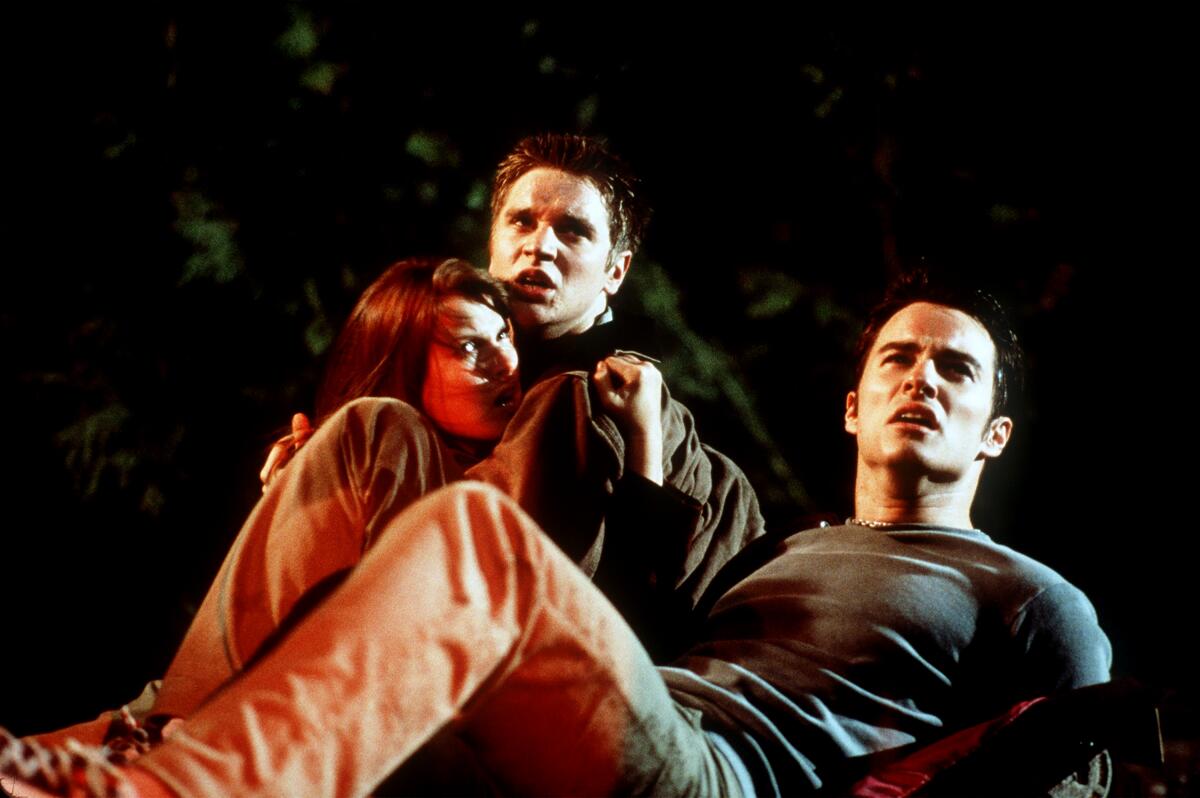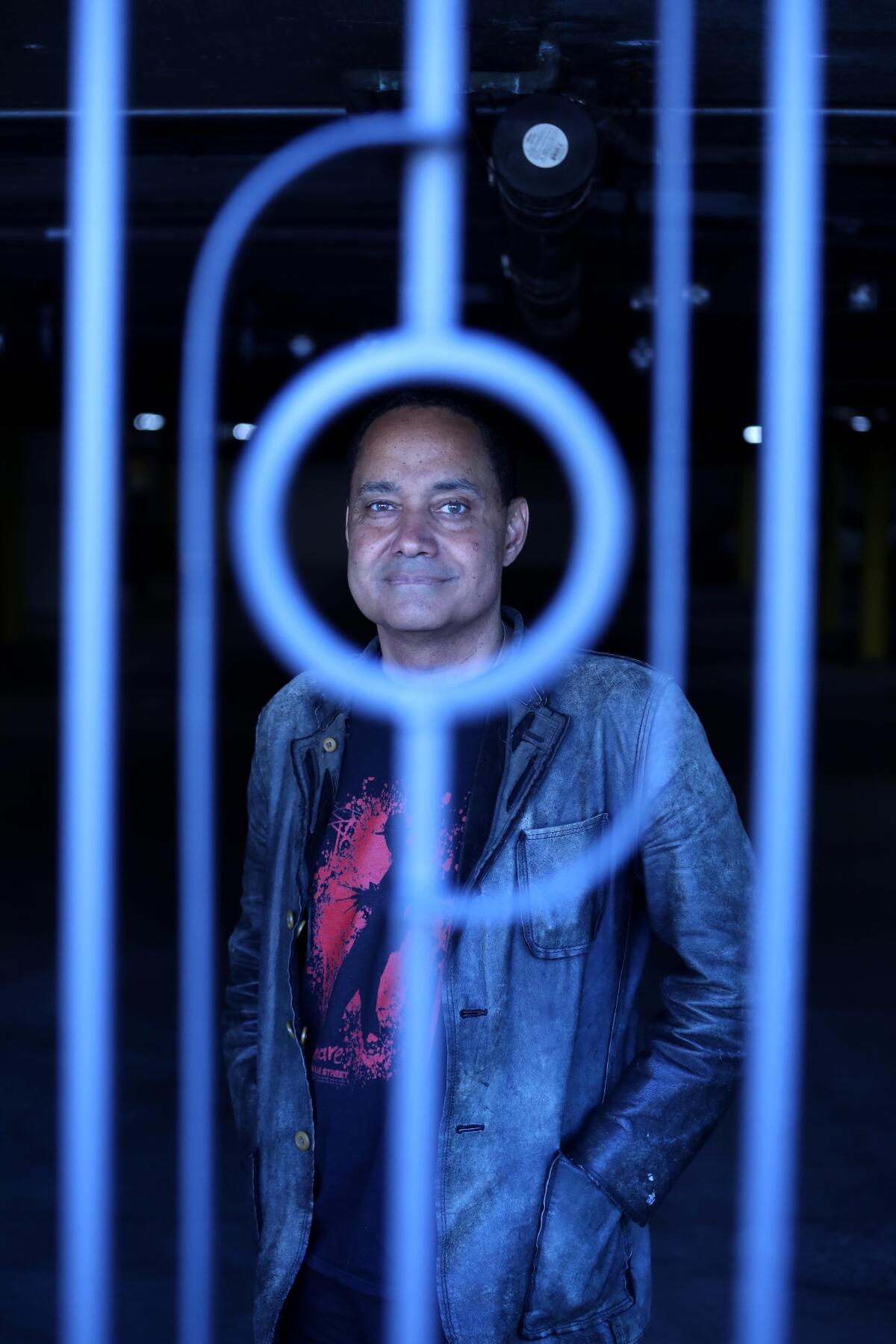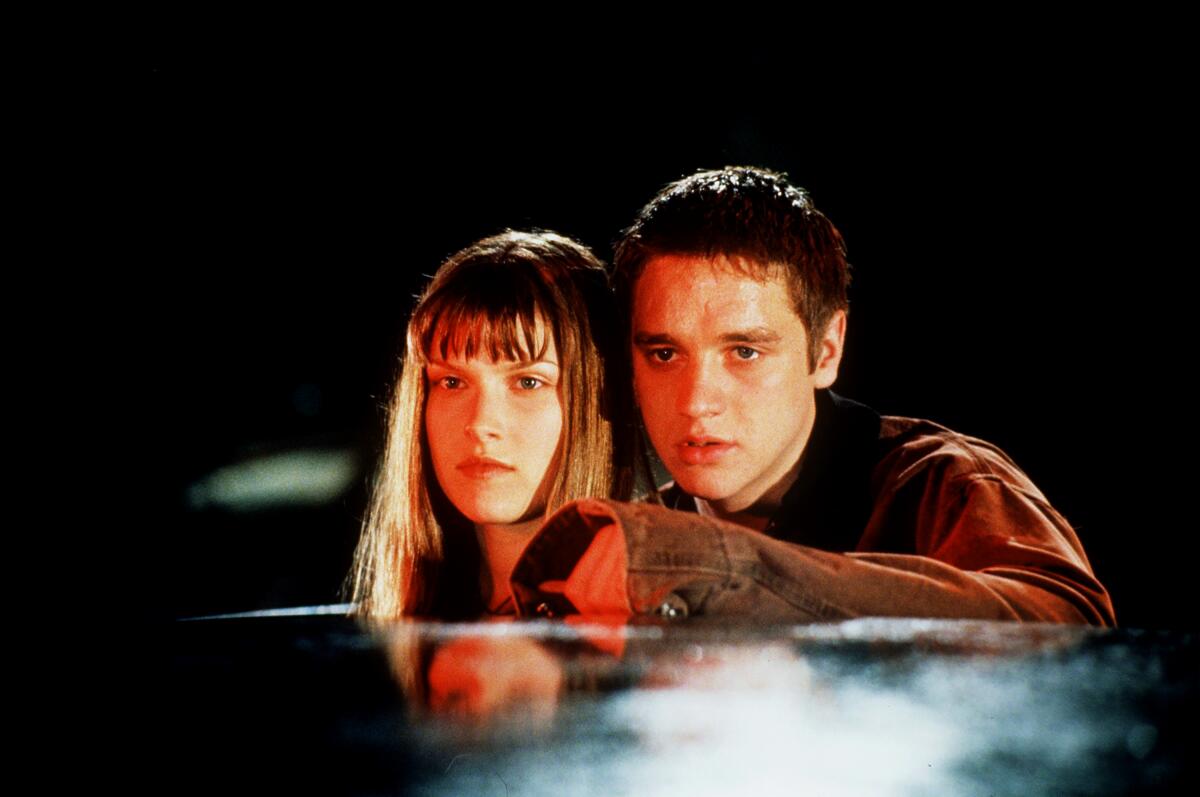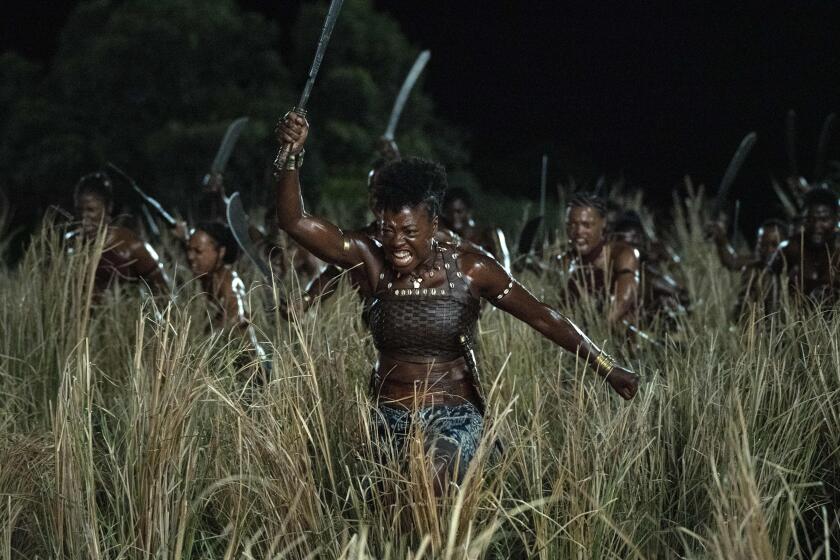‘Final Destination’ creator Jeffrey Reddick on how the horror franchise should evolve

- Share via
In 1997, Jeffrey Reddick sold a script treatment with a killer hook about airline passengers who thwart fate by escaping a deadly disaster, only to be methodically targeted by death itself. The studio: New Line Cinema. The movie, the first in a franchise of films, comics and novels steeped in aughts-era dread: “Final Destination.”
The efficiency of an omnipresent villain using darkly comedic Rube Goldberg-style devices of everyday doom — rather than a literal Angel of Death, among other ideas left on the cutting room floor — offered inventive scares anyone across the world could relate to. Four sequels followed, with 2009’s mistitled fourth entry “The Final Destination” topping the series with a $186-million global box office.
Update:
9:04 a.m. Oct. 18, 2023This story has been updated with comment from “Final Destination” filmmakers Glen Morgan and James Wong.
The downside, Reddick jokes on a recent afternoon, of the 2000 horror hit that launched his career, “is that I don’t have a toy line. All my other friends have their Chuckys and their Michael Myers masks and their Jason Voorhees and Freddy Kruegers. All I want is one toy!”
There may not be a “Final Destination” collectible playset — yet. (Bus, log truck, roller coaster? Check.) But a dozen years since “Final Destination 5” seemingly closed the loop on the canon, another sequel is in the works, stoking anticipation as well as renewed appreciation for the Y2K original.

Over time, Reddick’s own relationship with the film has deepened in unexpected ways, he said ahead of a recent “Final Destination” screening and Q&A at Beyond Fest, in partnership with the American Cinematheque. Many fans of the series, for instance, have no idea that the creator of “Final Destination” is a biracial gay man shaped by his upbringing in the Kentucky Appalachians.
“I have had people, especially LGBTQ people, come up to me at conventions and say, ‘When I was younger, I was going to kill myself, and then I found out that the guy who wrote my favorite movie was gay,’” Reddick, 54, says, visibly moved, as we sit in the courtyard of his West Hollywood home.
Reddick, whose other writing credits include “Tamara” (2005), “Day of the Dead” (2008), Netflix’s “Samurai Rabbit” and his own 2020 directing debut, “Don’t Look Back,” saw 1984’s “Nightmare on Elm Street” from a friend’s dad’s pickup truck at a drive-in theater when he was 14. “I went home and I typed up a sequel idea,” he said of the pitch that, five years later, got him a career-launching internship at New Line.
This article was originally on a blog post platform and may be missing photos, graphics or links.
It was an “X-Files” spec script — in which a premonition leads a man to bail on a doomed flight — that New Line eventually bought from Reddick and developed into “Final Destination.” With a screenplay credited to Glen Morgan, James Wong and Reddick and directed by Wong, the film starred a cast led by Devon Sawa and Ali Larter as teens being supernaturally hunted after escaping death’s plan during a class trip.
But while he says he “adores the whole cast,” Reddick laments the film’s lack of diversity, blaming a time in Hollywood where actors of color simply were not given the same chances as their white counterparts. “All the kids are white,” he said of the New York-set film’s lead cast. “All the kids in the background are white. Even in the ’90s and the 2000s, there was a whole pool of talent that was never looked at.”
Following publication of this story, Morgan and Wong contacted The Times to dispute Reddick’s characterization of his involvement in the creation of the franchise, in particular its distinctive conception of death.
“The aphorism ‘success has many fathers while failure is an orphan’ certainly rings true for ‘Final Destination,’” Wong wrote in an email. “The crux of the franchise, the thing that made the whole thing original, was something [Reddick] had nothing to do with. The fact that death took the form of an invisible force around us, deploying its tentacles around inanimate objects to deadly [effects], was the one thing that made ‘Final Destination’ a franchise. That idea came from our screenplay.”
Sporting a Freddy Krueger tee on a sunny October day, Reddick spoke to The Times about his own creative journey, his history with the franchise and how he’d like to see it come full circle with the forthcoming “Final Destination 6.”

I’m sure you get asked this a lot, but are you totally comfortable traveling on airplanes?
Oh, yeah. I did go to a horror convention in Colorado a couple of weeks ago, and for some reason, I got a weird [feeling]. It’s never happened before, but I think it was just stress. I thought, “Well, I hope they don’t play John Denver at the airport.”
I have a friend who checks and tests the tray latch every time she takes a flight, just to be sure.
Tell her I have a good feeling that she’s going to be OK.
“Final Destination” came out in 2000, but your idea struck more than 25 years ago, after reading an article about a woman who skipped a flight because of a bad vibe. Take me back: Where were you in your life then?
I’d written a couple of horror scripts. I was trying to get a TV agent, so I wrote a spec script for one of my favorite shows on TV, “The X-Files,” where Scully’s brother Charles had the premonition. He gets off the plane and the other passengers are dying and they think he did it. But my friends at New Line were like, “That’s a great idea. Write it as a feature.” So I wrote a treatment, with a different man having a premonition. We worked on it for eight months and kept submitting it to New Line.
At first [the characters] were all adults. Then “Scream” came out and New Line was like, “Teenagers are hot now.” So I changed them to teenagers. It was a tough sell. They were like, “How can we have a horror movie where Death is a villain and you can’t fight it or see it?” We said, “That’s the whole point.” Once we threatened to take it to Miramax they said, “We’ll buy it.” [Laughs] Thank goodness, that didn’t happen.
They were like, “How can we have a horror movie where Death is a villain and you can’t fight it or see it?” We said, “That’s the whole point.”
— Jeffrey Reddick
You wrote a “Nightmare on Elm Street” sequel at 14, then somehow got it to New Line. How did that lead to you breaking into the film industry?
I found the address for New Line Cinema and Bob Shaye’s name and I mailed it to Bob. He sent it back saying, “We don’t take unsolicited material.” So I wrote him back and said, “Look, sir. I’ve spent $3 on your movies. I think you can take five minutes to read my story.” I’m this little hillbilly, living in a trailer in Kentucky, and he wrote me back. He said, “Thank you for your aggressive introduction.” He gave me some pointers and his assistant’s name, Joy Mann.
From age 14 to 19, I could call them. I called Joy collect. I didn’t know how the movie business worked. She would send me scripts over the years to read, and Bob would read my stuff. When I finally got to New York, they asked, “Do you want to intern here?” It’s a testament to a little bit of country gumption.
How did growing up in Kentucky shape you?
I grew up in rural eastern Kentucky. I joke that we were like a Loretta Lynn song: We were poor but we had love. There were good people that work hard and would give you the shirt off their back. I think J.D. Vance advanced a lot of negative stereotypes that we have about Appalachia, which is where I grew up. I’m very proud of having grown up there, because it taught me a lot about valuing other people and that money is unimportant to somebody’s self-worth. It is kind of a forgotten place. People don’t know that much about it. So I do my best to represent it.
Where do you think your storytelling impulse comes from?
The downside of where I grew up is — and this is also a time capsule, I want to make sure I’m very clear about this — my mom’s white, we moved back to take care of her grandparents and that region was very racist at the time. And my mom was very good about telling us, “Don’t be angry at the people. They don’t know any better because they’ve never seen somebody like you. Give them time to know you and they will change.” And they did. But when I was young, it was really hard. I had to be funny not to get beat up. I had to learn how to tell stories, to entertain people. A lot of that was for survival and for escape. My sister is the opposite. She’s in the military. She will punch anybody in the face, and God love her for it.

“Final Destination” is about death literally lurking around every corner, which is universally relatable. But there’s something even more pointed about the concept knowing that it came from a writer of color.
A lot of people don’t know that I’m a person of color, that I’m gay. I have had people, especially LGBTQ people, come up to me at conventions and say, “When I was younger, I was going to kill myself, and then I found out that the guy who wrote my favorite movie was gay.” That’s the reason I’ve always been out. If I can help one person, I don’t care about the effects or if it’s going to hurt my career, which it would back in the day. Not so much now. But people don’t realize how much times have changed, yet haven’t changed.
Has that struck you more over the years? Even as a person who loves horror, I have very rarely if ever seen myself reflected in the genre.
Any time there’s progress, there’s always pushback, and we’re in a pushback phase of progress right now. But the pushback is coming from this misguided place that super talented white actors and actresses are being passed over for jobs by untalented people of color. And that couldn’t be further from the truth. When I wrote “Final Destination” in ’97, and I said, “It’s set in New York, the most diverse city in the world, so let’s make sure our cast looks like New York,” it wasn’t about pushing an agenda. It was about seeing representation of reality. And I adore the whole cast. They’re amazing — Devon Sawa, especially, and Tony Todd. But we cast the movie, and all the kids are white. All the kids in the background are white. Even in the ’90s and the 2000s, there was a whole pool of talent that was never looked at.
It wasn’t about pushing an agenda. It was about seeing representation of reality.
— Jeffrey Reddick
White actors and actresses have always been the default for leading roles. And people of color would sometimes get pulled in for, like, the best-friend role. “Final Destination” is a great example. I have had other movies where I’ve specifically written characters to be of color and the casting directors just get white people submitted. I had one of my movies where an actress of color was the top choice for the lead, and the producers and distributors loved her, but they were like, “We can’t sell [the movie]. That’s not going to sell with her as a lead.”
You’re also an actor. What was your experience pursuing a career in front of the camera?
I got an acting agent in New York in the early ’90s and she was very honest. She said, “You’re an ethnic Michael J. Fox type.” And I’m like, “Great, everybody loves Michael J. Fox.” She said, “Yeah, but they don’t write roles for ethnic Michael J. Fox types. If you could rap or play basketball, there are plenty of auditions I can get you.” The reality is, there’s a talent pool that’s just not been looked at. And now we’ve started shining a light on that pool of talent. That was the problem with “Final Destination.” I didn’t have an agenda. As a fan, of course I want to see people that look like me onscreen. But I just want to see diversity, especially [in characters] from New York.
Representation by people of color as movie leads and film writers has slid back to 2019 levels, according to UCLA’s Hollywood Diversity Report.
Once you got into the director’s chair, with your 2020 debut, “Don’t Look Back,” about bystanders who watch a man get beaten to death and are then mysteriously targeted, you centered on characters of color. What did it take to come to that milestone?
It was great because I got to cast the people I wanted to cast. Courtney Bell was the lead, and she’s a really good actress. A part of me felt tired of other people doing my stuff. I wanted to do one of my own. So I picked “Don’t Look Back” because we had a company that was going to finance it for a good-sized budget. Then the company closed their feature arm, so we decided to go the indie route with it, which was a great learning experience.
You have a story credit and an executive producer credit on “Final Destination 2.” Did you want to write it yourself?
It would have been interesting, but at the time, I thought, “At least they’re greenlighting one and it’s going immediately, because I’m going to finish this TV movie I’m writing.” And actually, I love the sequel. The log truck scene came to me when I was going home to Kentucky and got behind a log truck. David R. Ellis, who’s no longer with us, was an amazing director and stunt person.

You weren’t creatively involved in the other sequels. Do you want to be?
It would be interesting to go back to it. The funny thing is, they haven’t asked me. I don’t hold any ill feelings because I do love how they’ve turned out. Especially the fifth one, I thought, was brilliant. The screenwriters of the new one [“Scream” reboot scribe Gary Busick and Lori Evans Taylor] called me. They wanted to know what was important to me. It was very nice of them. I respect their work a lot. John Watts came up with the story. And we’ve got the directors of “Freaks” directing. So it’s a superstar team on the new one.
And what is important to you as the franchise continues?
I don’t like the idea that everybody dies at the end of [the films]. It’s too cynical. It becomes a point of, “Why are we watching this if everybody’s going to die in the end?” So I kept pushing to bring some survivors back. Because I want the idea to be that you can’t cheat death — death is inevitable for all of us — but you can prolong your life.
And I saw that through my mother. She lived to be 97 and had cancer tumor surgery at 87, and they said, “She’s not going to survive the surgery.” Ten years after all the doctors said she wouldn’t be with us, she was still with us, and very sound of mind. So I’ve seen how strong we can be, how strong people can be. We just often don’t see it.
More to Read
Only good movies
Get the Indie Focus newsletter, Mark Olsen's weekly guide to the world of cinema.
You may occasionally receive promotional content from the Los Angeles Times.












